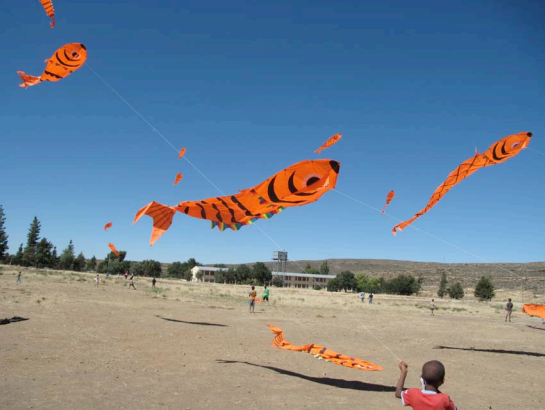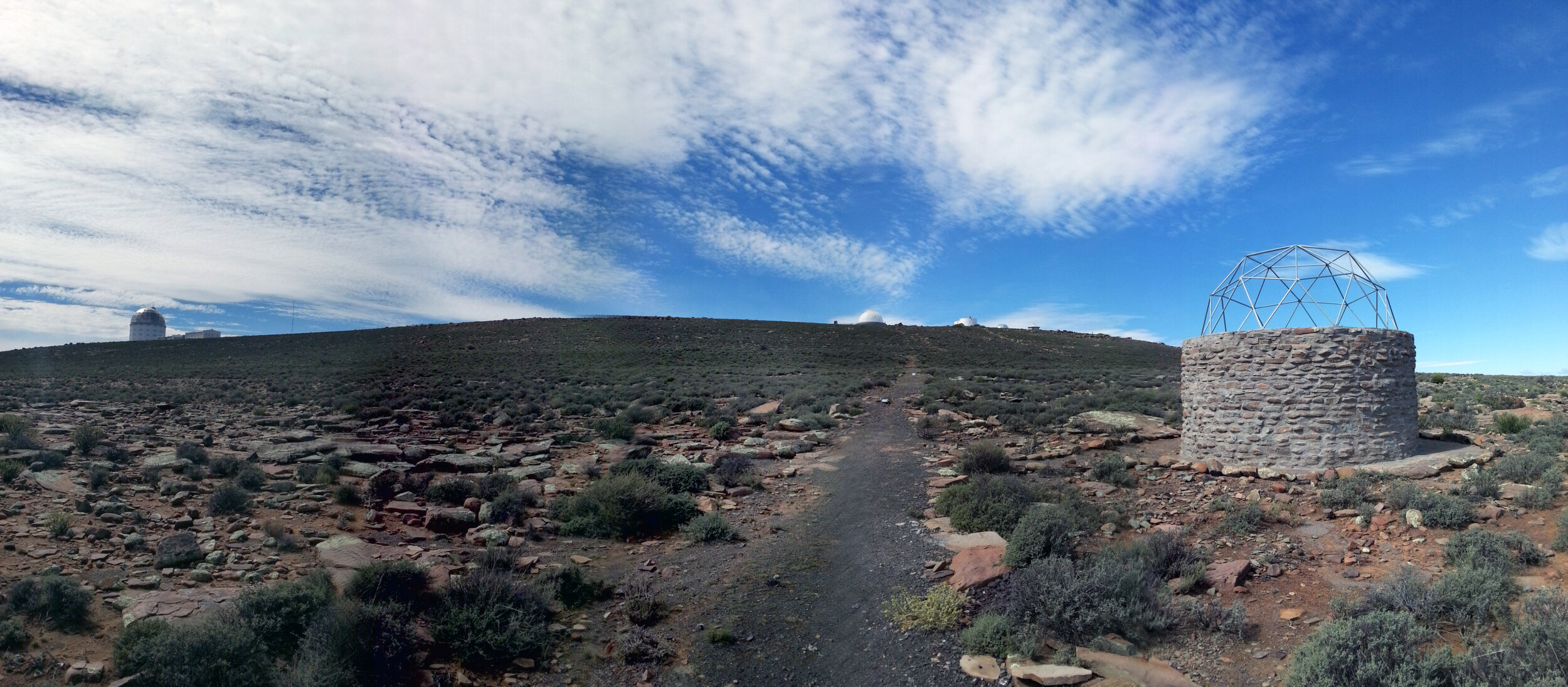Astronomers and the Art of Reconciliation
Can artists help astronomers resolve this unpleasant truth? The places where scientists build telescopes often belonged to other people there before them. For example - before the Spanish arrived, the native Luiseño people occupied land around today's Palomar Observatory. In 1958, American astronomers started building telescopes on Kitt Peak in Arizona, part of the tribal reservation of the Tohono O’odham Nation. Today, in Hawai’i, native Hawaiians are challenging astronomers over construction of the Thirty Meter Telescope on Mauna Kea. A recent court order has stopped the project for now. This tension between astronomers and indigenous people isn’t limited to the United States. From Capetown, it’s a long and dusty drive for scientists visiting the South African Astronomical Observatory. Its telescopes sit amidst the Roggeveld Mountains, more than a mile above sea level in a semi-desert region called the Karoo. The astronomers are not alone in the Karoo though. Below the plateau and its the observatory, is the small town of Sutherland. Founded in the 18th century, British soldiers used it as a fort during the Anglo-Boer War. After passage of the Native Land Act in 1913, over 3 million black residents of South Africa were forcibly removed from their land. Sutherland was no exception to this racial violence.Today, about 4,000 people call Sutherland home. Almost 90% of them are either “Black African” or “Coloured” (an official term for people of mixed ethnicity from Europe, Asia, and different African tribes). As is the case on Native American reservations in the U.S., unemployment, poor education, and substance abuse are persistent problems.
This tension between astronomers and indigenous people isn’t limited to the United States. From Capetown, it’s a long and dusty drive for scientists visiting the South African Astronomical Observatory. Its telescopes sit amidst the Roggeveld Mountains, more than a mile above sea level in a semi-desert region called the Karoo. The astronomers are not alone in the Karoo though. Below the plateau and its the observatory, is the small town of Sutherland. Founded in the 18th century, British soldiers used it as a fort during the Anglo-Boer War. After passage of the Native Land Act in 1913, over 3 million black residents of South Africa were forcibly removed from their land. Sutherland was no exception to this racial violence.Today, about 4,000 people call Sutherland home. Almost 90% of them are either “Black African” or “Coloured” (an official term for people of mixed ethnicity from Europe, Asia, and different African tribes). As is the case on Native American reservations in the U.S., unemployment, poor education, and substance abuse are persistent problems. After telescopes started being built on the plateau above Sutherland in the 1970s, local people's access to the observatory’s land was restricted. A vast gulf of race, education, and privilege separated the locals from the South African, European, and American scientists who worked at the telescopes. The isolation of local people from the nearby telescopes and the scientists who used them was exacerbated by stunted economic development. There was a cruel irony to this. The success of the telescopes at Sutherland relied on the availability of dark night skies. The observatory's management preferred the status quo and there was little incentive to encourage modern houses, paved roads, or shopping complexes. Already socially and economically disempowered, local history and politics were keeping the people in Sutherland - literally - in the dark. And, in a country with a long legacy of violence and high crime rates, the idea of "darkness" meant something quite different to the townspeople of Sutherland than it did to the scientists.Starting in 2009 – as part of the International Year of Astronomy – South African artist-activist Marcus Neustetter and his partner/fellow artist Bronwyn Lace launched a series of interventions to re-connect the people of Sutherland with the landscape around them. Their first effort, called Sutherland Reflections, started with the organization of kite flying workshops. Local children flew them around Sutherland, creating a link between earth and sky.
After telescopes started being built on the plateau above Sutherland in the 1970s, local people's access to the observatory’s land was restricted. A vast gulf of race, education, and privilege separated the locals from the South African, European, and American scientists who worked at the telescopes. The isolation of local people from the nearby telescopes and the scientists who used them was exacerbated by stunted economic development. There was a cruel irony to this. The success of the telescopes at Sutherland relied on the availability of dark night skies. The observatory's management preferred the status quo and there was little incentive to encourage modern houses, paved roads, or shopping complexes. Already socially and economically disempowered, local history and politics were keeping the people in Sutherland - literally - in the dark. And, in a country with a long legacy of violence and high crime rates, the idea of "darkness" meant something quite different to the townspeople of Sutherland than it did to the scientists.Starting in 2009 – as part of the International Year of Astronomy – South African artist-activist Marcus Neustetter and his partner/fellow artist Bronwyn Lace launched a series of interventions to re-connect the people of Sutherland with the landscape around them. Their first effort, called Sutherland Reflections, started with the organization of kite flying workshops. Local children flew them around Sutherland, creating a link between earth and sky. At night, Neustetter and Lace gathered participants and, using hundreds of glow sticks, they made patterns resembling galaxies and star formations.
At night, Neustetter and Lace gathered participants and, using hundreds of glow sticks, they made patterns resembling galaxies and star formations. Over the next six years, Neustetter and Lace expanded their project which they described as "Art Meets Science in a Place of Darkness and Silence " In 2013, their intervention took on a more concrete form. After two years of relationship building with observatory staff and management, Neustetter, Lace, and people from Sutherland claimed a small piece of land on the observatory grounds. There, they assembled a small circular structure - the Sutherland Dome - using local stones and traditional building methods.
Over the next six years, Neustetter and Lace expanded their project which they described as "Art Meets Science in a Place of Darkness and Silence " In 2013, their intervention took on a more concrete form. After two years of relationship building with observatory staff and management, Neustetter, Lace, and people from Sutherland claimed a small piece of land on the observatory grounds. There, they assembled a small circular structure - the Sutherland Dome - using local stones and traditional building methods. On top of the structure, they placed a metal lattice. The dome's framework provides a grid - analogous to the astronomer's ancient tool, the mural quadrant - that people can use to track the motion of stars and planets. Or visitors can just sit there and watch the sky spin silently overhead.
On top of the structure, they placed a metal lattice. The dome's framework provides a grid - analogous to the astronomer's ancient tool, the mural quadrant - that people can use to track the motion of stars and planets. Or visitors can just sit there and watch the sky spin silently overhead. The Sutherland project also involved archaeologists who explored the territory nearby. They found stone artifacts, dinosaur foot prints, petroglyphs, and the recent remains of local residences that had been forcibly destroyed. These explorations of "deep time" re-connected locals to the past, which for some, still held memories of traumatic events. Working with the group Africa Meets Africa, Neustetter and Lace also contributed to a book called My Room at the Center of the Universe. Its story - made into a documentary - follows a Sutherland-area teen as he works to understand his place in the community and the cosmos. ((For another look at astronomy in Africa and its broader culture, see this.))
The Sutherland project also involved archaeologists who explored the territory nearby. They found stone artifacts, dinosaur foot prints, petroglyphs, and the recent remains of local residences that had been forcibly destroyed. These explorations of "deep time" re-connected locals to the past, which for some, still held memories of traumatic events. Working with the group Africa Meets Africa, Neustetter and Lace also contributed to a book called My Room at the Center of the Universe. Its story - made into a documentary - follows a Sutherland-area teen as he works to understand his place in the community and the cosmos. ((For another look at astronomy in Africa and its broader culture, see this.)) Compared to the massive domes visible nearby, the Sutherland Dome is scarcely noticeable. Its importance comes from something other than size. It connects the local people of Sutherland with land that was once theirs and the night sky they share with astronomers. More than giving a resolution to the problems facing people of Sutherland, Neustetter and Lace's work offers reconciliation. At the root of this is encouraging the scientists to notice the people living around them. "If you're looking up all the time," Neustetter - who is a fellow at the Smithsonian's National Air and Space Museum with me - said, "you often don't see what's on the ground."In Hawai'i, the conflicts between astronomers and indigenous peoples are being resolved by legal channels against a backdrop of Twitter campaigns and public statements. With their interventionist art, Marcus Neustetter and Bronwyn Lace have taken steps down another path. Could something similar to the Sutherland project be experimented with in Hawai'i? Astronomy, like art, is about asking questions - who you are, where you’ve come from, and where you will go. Both sides in today's disputes have an interest in reconciling the answers they find to these questions.
Compared to the massive domes visible nearby, the Sutherland Dome is scarcely noticeable. Its importance comes from something other than size. It connects the local people of Sutherland with land that was once theirs and the night sky they share with astronomers. More than giving a resolution to the problems facing people of Sutherland, Neustetter and Lace's work offers reconciliation. At the root of this is encouraging the scientists to notice the people living around them. "If you're looking up all the time," Neustetter - who is a fellow at the Smithsonian's National Air and Space Museum with me - said, "you often don't see what's on the ground."In Hawai'i, the conflicts between astronomers and indigenous peoples are being resolved by legal channels against a backdrop of Twitter campaigns and public statements. With their interventionist art, Marcus Neustetter and Bronwyn Lace have taken steps down another path. Could something similar to the Sutherland project be experimented with in Hawai'i? Astronomy, like art, is about asking questions - who you are, where you’ve come from, and where you will go. Both sides in today's disputes have an interest in reconciling the answers they find to these questions.